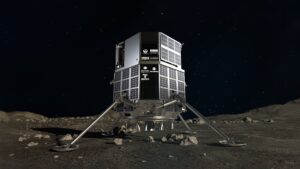Japan’s ispace plans to land a spacecraft on the Moon’s Sea of Cold, taking a longer lunar route heading

Ispace, a Tokyo-based lunar exploration company, has announced the details of its second lunar mission, SMBC x HAKUTO-R Mission 2, during a keynote address. The company confirmed that the mission will launch within a six-day window beginning in mid-January 2025, aboard a SpaceX Falcon 9 rocket, alongside Firefly Aerospace’s Blue Ghost Mission 1.
The Resilience lunar lander, developed by ispace, will follow a low-energy trajectory similar to its predecessor in Mission 1. This approach will extend its journey to several months, with the lunar landing expected to occur four to five months after launch.
“Mission 2 reflects our ongoing dedication to the lunar economy,” said Takeshi Hakamada, Founder & CEO of ispace. “Our team, shareholders, and partners have worked relentlessly on the RESILIENCE lander and the TENACIOUS lunar micro-rover. With numerous global organizations focusing on the Moon, ispace aims to take the lead in creating a sustainable lunar ecosystem. See you on the Moon!”
Ispace’s previous attempt to land a spacecraft on the Moon ended in failure, as the Hakuto-R M1 lander, carrying the UAE’s Rashid rover, crashed on the lunar surface in April 2023.
MISSION OBJECTIVES
Mission 2 builds upon the HAKUTO-R program’s achievements, with a clear roadmap outlining 10 key milestones from launch to landing.
One of the major highlights will be a lunar flyby, set to occur about a month into the journey, which will make RESILIENCE the first commercial lander to perform this maneuver.
Upon reaching lunar orbit, the lander will aim for a soft landing near Mare Frigoris (Sea of Cold) at coordinates 60.5°N, 4.6°W, chosen for its optimal sun exposure and communication advantages. Backup sites are also identified to provide flexibility for the mission.
SURFACE OPERATIONS: VENTURES AND INNOVATIONS
Upon landing, the European-built TENACIOUS micro-rover, co-funded by the Luxembourg Space Agency, will be deployed for groundbreaking exploration. The rover will deliver the MoonHouse payload, collect lunar regolith for NASA, and demonstrate operational capabilities under ispace-EUROPE’s control.
Mission 2 underscores the growing collaboration between private space companies and international agencies, advancing the development of a sustainable lunar economy. The mission’s results will help refine ispace’s strategy for future lunar exploration and commercialization.
“ispace will continue to build on the successes of Mission 2 to lead the world in shaping the lunar economy,” said Takeshi Hakamada, Founder & CEO of ispace. “We invite you to join us. See you on the Moon!”








